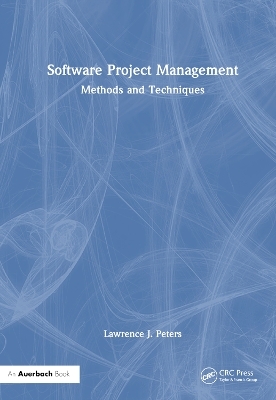
Software Project Management
Auerbach (Verlag)
978-1-032-77413-8 (ISBN)
The management of a software project has been shown to be the number one factor in determining a software development project’s success. It has been found that most software projects fail because of poor management. Not surprisingly, most software development managers have not been trained in project management. Software Project Management: Methods and Techniques aims to remedy this situation in two ways: familiarizing software developers with the elements of the project management discipline and providing fact-based resources on practicing software project management.
Much like the checklist pilots go through prior to a flight, this book provides a pre-project checklist which enables the software engineering team to review and evaluate an extensive set of technical and sociopolitical risks which will help the software project manager and the team determine the project team’s chances of success. This same list and the individual question responses can be used later as part of the project’s closeout process helping team members to improve their individual and collective abilities to assess risk.
Intended for both students and software project managers, the book is organized along the lines of the five major functions of a software project manager: planning; scheduling and costing; controlling; staffing; and motivating. The basics of each of these functions are presented in a single chapter. These are followed by a series of narrow topic presentations in the form of appendices that are intended to help solve specific problems that may occur during the conduct of a software project. As in the main portion of the text, the appendices include references that provide an avenue into further detail on the topic. Designed to promote project success, this approach has been taken because software projects are each unique undertakings such that providing a "one size fits all" approach will fail most of the time.
Lawrence J. Peters has a B.S. in Physics, an M.S. in Engineering and in 2002 a Ph.D. in Engineering Management and a CSDP (Certified Software Development Professional). He has applied software engineering technology for more than 50 years in the aerospace, defense, financial, manufacturing and software engineering fields. He authored the first software engineering curriculum published by the ACM and has since developed and implemented software engineering curricula at three universities as well as the syllabus for software project management at three other universities. Throughout his career, he has been a thought leader in the field of software project management and has successfully managed and consulted on dozens of projects as large as $20 million. He currently teaches Software Project Management in English remotely at Universidad Politecnica de Madrid from his office near Seattle, Washington, and has taught that subject at other schools. He has published several papers on the subject.
Overview. 1 Introduction to Software Project Management. 2 Planning Software Projects. 3 Estimating Cost and Schedule of Software Projects. 4 Controlling. 5 Staffing. 6 Motivating. 7 Project Closeout. APPENDICES ADDITIONAL SOFTWARE PROJECT MANAGEMENT RESOURCES. Appendix 1 A Word from Our Sponsor – The Brain. Appendix 2 Basics of Negotiation. Appendix 3 Brainstorming. Appendix 4 Characteristics of Successful High-Technology Teams. Appendix 5 Computing the Cost of a Change. Appendix 6 Developing a Business Case. Appendix 7 Developing the Project Closeout Plan. Appendix 8 The Effect of Cultural Differences (on Software Development Teams). Appendix 9 Emotional Intelligence. Appendix 10 Environmental Factors Affecting Productivity. Appendix 11 How Software Project Managers Are Evaluated. Appendix 12 How to Run Effective Meetings. Appendix 13 Ishikawa (Fishbone) Diagrams. Appendix 14 Knowing When It Is Time to Cancel a Project. Appendix 15 Lying and Software Projects. Appendix 16 Managing Multiple Generations. Appendix 17 Outsourcing (Offshoring). Appendix 18 PERT [Program Evaluation Review Technique]. Appendix 19 Planning using Integrated Cost and Schedule Work Packages. Appendix 20 A Pre-Project Launch Checklist. Appendix 21 Putting Pressure on the Team Can Reduce Productivity. Appendix 22 Reducing Affinity Bias. Appendix 23 Risk Management Methods. Appendix 24 Software Project Management Antipatterns. Appendix 25 Software Project Managers. Appendix 26 Software Engineering Ethics. Appendix 27 Technical Debt – The Ultimate Productivity Killer. Appendix 28 Transitioning from Software Engineer to Software Project Manager. Appendix 29 Why Smart People Make Dumb Decisions. Appendix 30 Why Software Engineering Teams Should Be Kept Intact. Appendix 31 Why We Don’t Learn from Success. Appendix 32 Stoplight Charts. Appendix 33 The Theory of Constraints. Appendix 34 Documenting the Undocumented. Appendix 35 Making Documentation Transparent. Appendix 36 Capability Maturity Model (CMM). Appendix 37 Motivation Basics. Closing Comments. Chapter Questions and Suggested Answers. Index.
| Erscheinungsdatum | 13.06.2024 |
|---|---|
| Zusatzinfo | 56 Tables, black and white; 20 Line drawings, black and white; 20 Illustrations, black and white |
| Verlagsort | London |
| Sprache | englisch |
| Maße | 178 x 254 mm |
| Gewicht | 612 g |
| Themenwelt | Mathematik / Informatik ► Informatik ► Software Entwicklung |
| Mathematik / Informatik ► Informatik ► Theorie / Studium | |
| Wirtschaft ► Betriebswirtschaft / Management ► Logistik / Produktion | |
| Wirtschaft ► Betriebswirtschaft / Management ► Projektmanagement | |
| Wirtschaft ► Volkswirtschaftslehre | |
| ISBN-10 | 1-032-77413-4 / 1032774134 |
| ISBN-13 | 978-1-032-77413-8 / 9781032774138 |
| Zustand | Neuware |
| Informationen gemäß Produktsicherheitsverordnung (GPSR) | |
| Haben Sie eine Frage zum Produkt? |
aus dem Bereich


